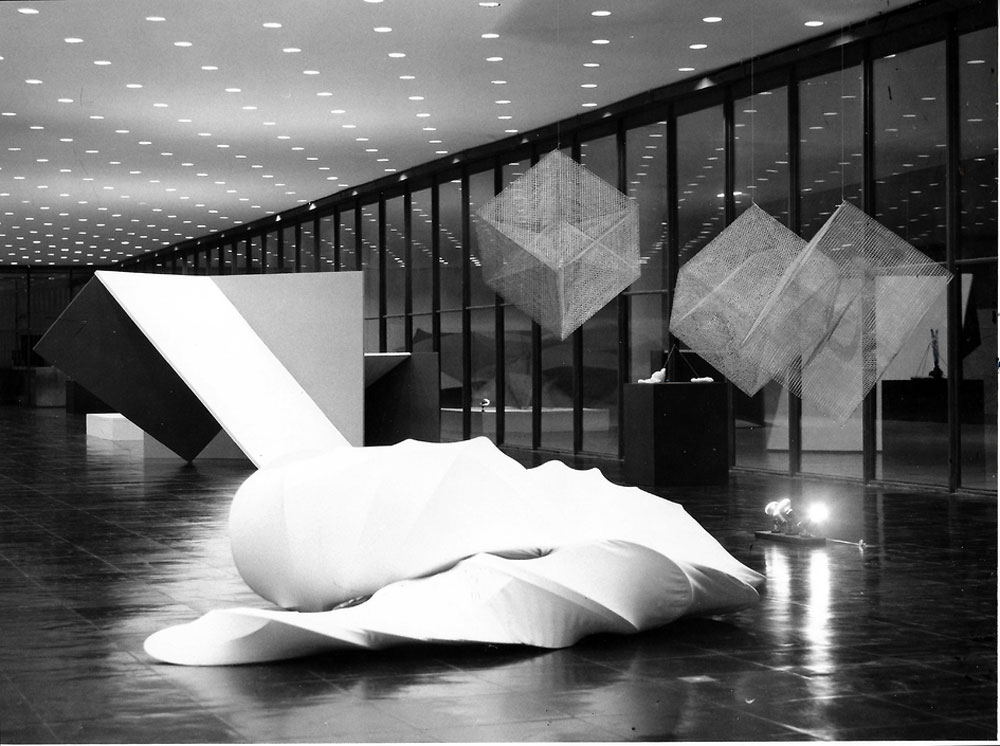ART CITIES:London Lydia Okumura
 For almost 50 years, Lydia Okumura has been investigating the interstice between two and three-dimensional space through precise, site-specific installations. Mostly using acrylic paint, cotton string, painted aluminum sheets, charcoal and pencil, Okumura constructs abstract geometric compositions that project from the walls into three-dimensional space. Although her practice can be framed within the minimalist tradition, op art is also at play. Through modest interventions, Okumura enhances our awareness of our bodily presence in the exhibition space.
For almost 50 years, Lydia Okumura has been investigating the interstice between two and three-dimensional space through precise, site-specific installations. Mostly using acrylic paint, cotton string, painted aluminum sheets, charcoal and pencil, Okumura constructs abstract geometric compositions that project from the walls into three-dimensional space. Although her practice can be framed within the minimalist tradition, op art is also at play. Through modest interventions, Okumura enhances our awareness of our bodily presence in the exhibition space.
By Efi Michalarou
Photo: Galerie Thaddaeus Ropac
In her solo exhibition “Volume ’84” Lydia Okumura presents five seminal site-specific installations, which were originally realised for her major solo exhibition at the Museu de Arte Moderna in São Paulo in 1984, highlight a watershed moment in Okumura’s career. Lydia Okumura was born in 1948 in São Paulo to a Japanese immigrant family and attended a Japanese school in Brazil, merging two very distinct cultural influences that continue to resonate in her work. She specialized in industrial ceramics and painting, which she displayed at her first solo exhibition at Varanda Galeria in 1968. From 1970-1973, she attended Fundação Armando Alvares Penteado and received her Bachelor of Fine Arts. In 1970, Okumura began working in a collective based in São Paulo named Equipe3 with artists Genilson Soares and Francisco Inarra. With their installation in the 1973 International Biennial of São Paulo titled “Pontos de vista” (Points of View), Okumura developed her signature style of extended geometrical compositions in site-specific spaces. She received a four-year scholarship to the Pratt Graphics Center in 1974 and moved to New York. Okumura first traveled to Japan in 1979 as a resident artist at Wako University, and subsequently has had numerous exhibitions in Japan. For almost fifty years, Lydia Okumura has transformed space through geometric abstraction, her work blurring the boundaries between illusion and reality and provoking a reassessment of the conventional art-object experience. She was the first Brazilian artist to have their work included in the permanent collection of the Metropolitan Museum of Art, New York in the 1970s. Her large-scale often site-specific geometric compositions, projected into three-dimensional space from walls and floors, they investigate the optical interplay between two- and three-dimensional forms. “Volume ’84”: In 1984, Ilsa Leal Ferreira, Director of the Museu de Arte Moderna (MAM) in São Paulo, invited Okumura to stage a solo exhibition at the Museu de Arte Moderna in the wake of her burgeoning successes in Japan, Bogotá, Brazil and New York. The invitation was impromptu, allowing Okumura just 30 days to create a sculptural vision for the entire museum. “I went home pondering the invitation’s condition as impossible, but my father said: ‘If nobody would do, why don’t you do it’.” In the month leading up to the exhibition, Okumura worked day and night with a local metal workshop to create 47 wall and floor installations, three-dimensional pieces made out of steel wires, wire mesh screens, wood panelling, and stretch fabric. In this landmark exhibition, Okumura showed an astute vision for the modernist architectural quality of the museum, filling it with works that focused on abstract volume, spatial rhythm and negative space. In contrast to her previous painted installations from the 1970s, her sculptural works from 1984 marked an evolution in Okumura’s color and material sensibility that resonated aesthetically with progressive post-modern design. The steel mesh cubes, for example, along with several other wire mesh and steel wire pieces, signalled a new material realm for Okumura: until then, the artist had not worked with these industrial raw materials. In this new series of works, Okumura also experimented with scale, perception, and form, creating radical new shapes and environments in the gallery space. The exhibition included “Labyrinth”, her largest painted wire sculpture to date, and the first that visitors could enter and move within – and White Volume, a grounded floor composition with a fluid, undulating form that intrinsically challenges perception. While her male contemporaries rose to international prominence, Okumura was not afforded the same visibility and institutional support following her exhibition in 1984. Only now, in today’s shifting political and cultural landscape, is her ground-breaking work receiving widespread critical acclaim and greater recognition.
Info: Galerie Thaddaeus Ropac, Ely House, 37 Dover Street, London, Duration: 28/1-23/3/19, Days & Hours: 10:00-18:00, https://ropac.net
